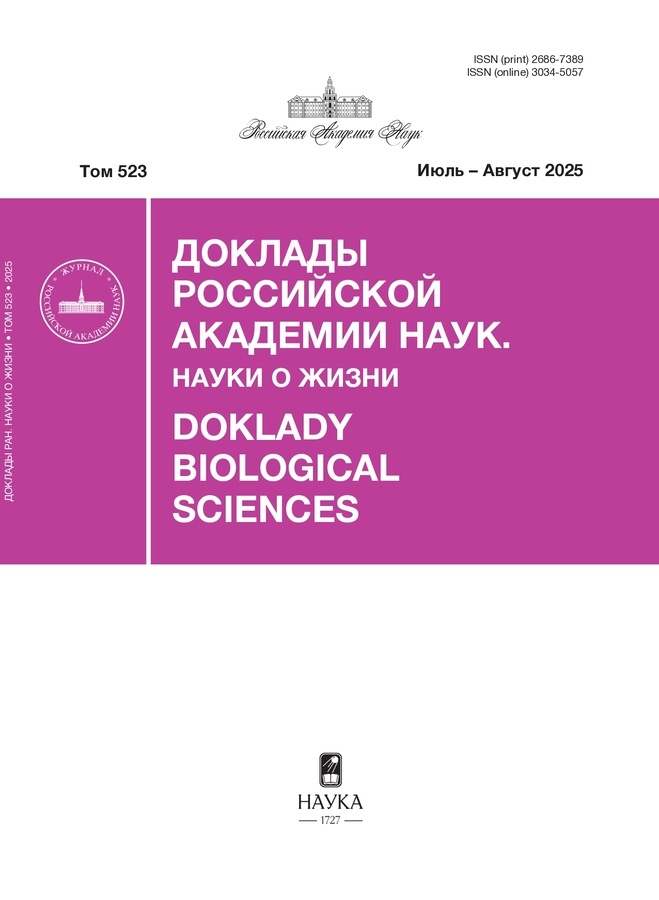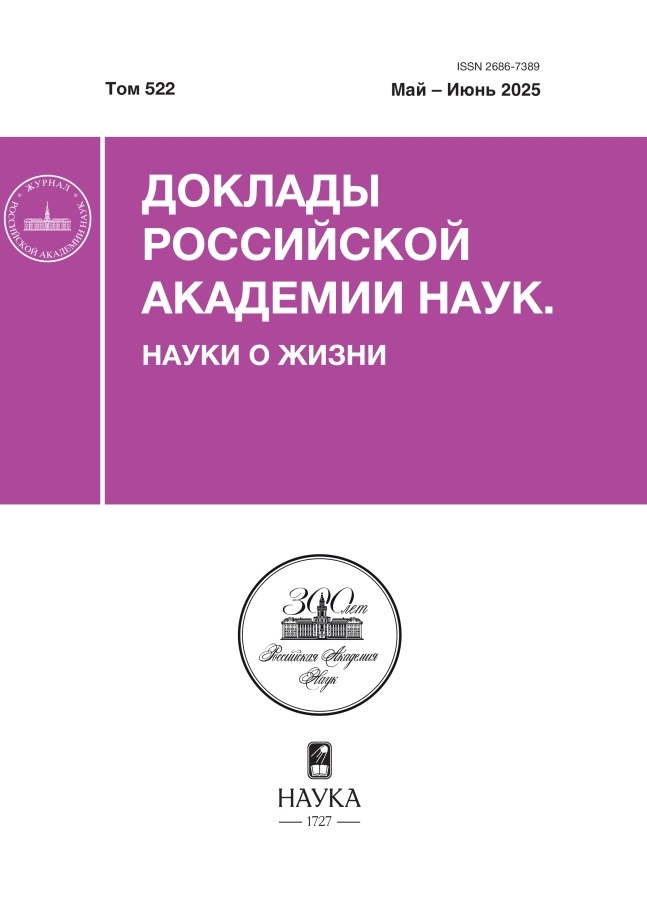New cellular partners of HIV-1 integrase and their role in viral replication
- Authors: Agapkina Y.Y.1, Ponomareva T.Y.1, Vdovina M.V.1, Ziganshin R.H.2, Rozina A.A.1, Anisenko A.N.1, Gottikh M.B.1
-
Affiliations:
- Lomonosov Moscow State University
- Shemyakin-Ovchinnikov Institute of Bioorganic Chemistry
- Issue: Vol 522, No 1 (2025)
- Pages: 324-329
- Section: Articles
- URL: https://kazanmedjournal.ru/2686-7389/article/view/686342
- DOI: https://doi.org/10.31857/S2686738925030029
- ID: 686342
Cite item
Abstract
Cellular proteins, partners of viral enzymes, are involved in the replication of the human immunodeficiency virus type I (HIV-1) at various stages. Thus, the viral enzyme integrase, participating in several stages of the viral cycle, interacts with various cellular proteins. A number of them are already known, and for some the mechanism of action has been established, but the search for integrase cellular partners continues. In this work, the identification of cellular partners of HIV-1 integrase has been carried out by the cross-linking method followed by mass spectrometry (XL-MS). Twelve new potential integrase partners have been identified, and some of them have been examined for their effect on the early stages of HIV-1 replication.
Full Text
About the authors
Y. Y. Agapkina
Lomonosov Moscow State University; Lomonosov Moscow State University
Author for correspondence.
Email: agapkina@belozersky.msu.ru
Department of Chemistry, A.N. Belozersky Research Institute of Physico-Chemical Biology
Russian Federation, Moscow; MoscowT. Y. Ponomareva
Lomonosov Moscow State University
Email: agapkina@belozersky.msu.ru
A.N. Belozersky Research Institute of Physico-Chemical Biology
Russian Federation, MoscowM. V. Vdovina
Lomonosov Moscow State University
Email: agapkina@belozersky.msu.ru
Department of Chemistry
Russian Federation, MoscowR. H. Ziganshin
Shemyakin-Ovchinnikov Institute of Bioorganic Chemistry
Email: agapkina@belozersky.msu.ru
Russian Federation, Moscow
A. A. Rozina
Lomonosov Moscow State University
Email: agapkina@belozersky.msu.ru
A.N. Belozersky Research Institute of Physico-Chemical Biology
Russian Federation, MoscowA. N. Anisenko
Lomonosov Moscow State University; Lomonosov Moscow State University
Email: agapkina@belozersky.msu.ru
Department of Chemistry, A.N. Belozersky Research Institute of Physico-Chemical Biology
Russian Federation, Moscow; MoscowM. B. Gottikh
Lomonosov Moscow State University; Lomonosov Moscow State University
Email: agapkina@belozersky.msu.ru
Department of Chemistry, A.N. Belozersky Research Institute of Physico-Chemical Biology
Russian Federation, Moscow; MoscowReferences
- Fauci A.S. HIV and AIDS: 20 years of science // Nat Med. 2003. V. 9. № 7. P. 839–843.
- Lingappa J.R., Lingappa V.R., Reed J.C. Addressing Antiretroviral Drug Resistance with Host-Targeting Drugs-First Steps towards Developing a Host-Targeting HIV-1 Assembly Inhibitor // Viruses. 2021. V. 13. № 3. P. 451.
- Jäger S., Cimermancic P., Gulbahce N., et al. Global landscape of HIV-human protein complexes // Nature. 2011. V. 481. № 7381. P. 365–370.
- Schynkel T., Snippenberg W.V., Verniers K., et al. Interactome of the HIV-1 proteome and human host RNA // EMBO ReP. 2024. V. 25. P. 4078–4090.
- Delelis O., Carayon K., Saïb A., et al. Integrase and integration: biochemical activities of HIV-1 integrase // Retrovirology. 2008. V. 5. P. 114.
- Engelman A.N. and Maertens G.N. Retrovirus-Cell Interactions. Academic Press, San Diego, CA, P. 163–198. 2018.
- Rozina A., Anisenko A., Kikhai T., et al. Сomplex Relationships between HIV-1 Integrase and Its Cellular Partners // Int. J. Mol. Sci. 2022. V. 23. P. 12341.
- Engelman A.N. and Kvaratskhelia M. Multimodal Functionalities of HIV-1 Integrase // Viruses. 2022. V. 14. P. 926.
- Ciuffi A., Llano M., Poeschla E., et al. A role for LEDGF/p75 in targeting HIV DNA integration // Nat Med. 2005. V. 11. P. 1287–1289.
- Yamamoto S.P., Okawa K., Nakano T., et al. Huwe1, a novel cellular interactor of Gag-Pol through integrase binding, negatively influences HIV-1 infectivity // Microbes Infect. 2011. V. 13. № 4. P. 339–349.
- Allouch A., Di Primio C., Alpi E., et al. The TRIM family protein KAP1 inhibits HIV-1 integration // Cell Host Microbe. 2011. V. 9. P. 484–495.
- Ait-Ammar A., Bellefroid M., Daouad F., et al. Inhibition of HIV-1 gene transcription by KAP1 in myeloid lineage // Sci ReP. 2021. V. 11. P. 2692.
- Hearps A.C., Jans D.A. HIV-1 integrase is capable of targeting DNA to the nucleus via an Importin α/β-dependent mechanism // Biochemical Journal. 2006. V. 398. № 3. P. 475–484. doi: 10.1042/bj20060466
- Dziuba N., Ferguson M.R., O’Brien W.A., et al. Identification of cellular proteins required for replication of human immunodeficiency virus type 1 // AIDS Res Hum Retroviruses. 2012. V. 28. P. 1329–1339.
- Yoder A., Yu D., Dong L., et al. HIV envelope-CXCR4 signaling activates cofilin to overcome cortical actin restriction in resting CD4 T cells // Cell. 2008. V. 134. P. 782–792.
- Speth C., Prohászka Z., Mair M., et al. A 60 kD heat-shock protein-like molecule interacts with the HIV transmembrane glycoprotein gp41 // Mol Immunol. 1999. V. 36. № 9. P. 619–628.
- Ha H.C., Juluri K., Zhou Y., et al. Poly(ADP-ribose) polymerase-1 is required for efficient HIV-1 integration // Proc Natl Acad Sci USA. 2001. V. 98. P. 3364–3368.
- Bueno M.T., Reyes D., Valdes L., et al. Poly(ADP-ribose) polymerase 1 promotes transcriptional repression of integrated retroviruses // J Virol. 2013. V. 87. № 5. P. 2496–2507.
- Ramakrishnan R., Liu H., Donahue H., et al. Identification of novel CDK9 and Cyclin T1-associated protein complexes (CCAPs) whose siRNA depletion enhances HIV-1 Tat function // Retrovirology. 2012. V. 9. P. 90.
- Knyazhanskaya E., Anisenko A., Shadrina O., et al. NHEJ pathway is involved in post-integrational DNA repair due to Ku70 binding to HIV-1 integrase // Retrovirology. 2019. V. 16. № 1. P. 30.
Supplementary files

Note
Presented by Academician of the RAS O.A. Dontsova











